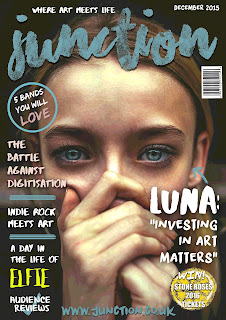Friday, 11 December 2015
Wednesday, 9 December 2015
Planning - Article for Double Page Spread
“THE BATTLE AGAINST DIGITISATION”
Undeniably, the world of music has become smaller over the past decade. So small that you could probably hold it in your hands. Oh wait, now you can.
With the establishment of free online streaming services such as Spotify and Deezer, the majority of the world’s music catalogue can be accessed through the simple click of a button on your phone. Of course, this is beneficial for music lovers who are potentially unable to buy physical albums and it provides an easy avenue to discovering new music. But is it an industry that thrives off the exploitation of artists?
What are the cons of artists having music on streaming services? Well, there is the large issue with paying out royalties. Spotify often catches a lot of criticism for its meagre royalty payments, which range from $0.006 to $0.0084 per stream. The company claims that a small indie band makes about $3,300 a month off an album, whilst a highly successful indie band makes $75,000 a month. Data from a 12-week period between June and August 2013 shows that 78.6 million streams on Daft Punk’s “Get Lucky” equated to only $660,000. This sum is then split between the record label, publishers, collecting societies and the artists themselves. On Pandora, one million plays results in only $1,370. As you can imagine, that is a very small sum of money to be divided then awarded to each musician. For many, it is not enough to even pay their rent. Is this fair?
In November 2014, in a highly publicised manoeuvre, Taylor Swift pulled her entire back catalogue off of Spotify. Writing in the Wall Street Journal in July of last year, Taylor Swift argues that “music is art, and art is important and rare. Important, rare things are valuable. Valuable things are paid for.” The singer believes that uploading music to streaming services is essentially artists underestimating themselves and undervaluing their art. She recently took a stab to Apple Music after its original policy refused to pay artists during free-trial periods. In an open letter to the company, Swift is disappointed that artists are being exploited despite the fact that Apple is more than capable enough of paying artists what they deserve. Adele has also followed the footsteps of Swift with the recent release of her highly anticipated comeback album, 25, which is currently unavailable on Spotify and Apple Music.
But artists like Adele and Swift are anomalies – they’re two of the very few artists who are able to pull this off and still remain popular.
Revival of the vinyl
However, new studies from the British Phonographic Industry (BPI) and the Entertainment Retailers Association (ERA) have shown that 69% of people would be more inclined to purchase music on a different format once they discovered it via a streaming service. So could it be that streaming services are actually encouraging physical sales? That could very well be the case. In fact, it appears vinyl is making an unexpected comeback. Even TESCO stock vinyl LPs after a successful trial in selling an Iron Maiden record in the summer. Some argue that this could be due to the revival of the indie genre, plagued with teenagers who find the “aesthetic” pleasing. Or, more optimistically, people could be realising the true value of music and that physically investing in it makes the experience a whole lot more worth it.
Tuesday, 8 December 2015
Production - Adobe Indesign
This is my first attempt at using Adobe Indesign CS5.5. I attempted at planning a double page spread with six text columns and an image that has the text wrapped around it.
Thursday, 3 December 2015
Progress of Production - Changes made to Contents Page
The contents page had to be changed in order to correspond with the front cover but very little change was actually made. Only the images of the models were swapped and the writing was made to fit within the frame of the new image.
Wednesday, 2 December 2015
Progress of Production - Changes made to Front Cover
Initially, the front cover was the image on the left. However, after much deliberation, it was decided that the model's appearance was not suitable for the genre of my magazine (indie-/alternative-/folk-rock). She exuded more of an innocent and pure image despite the indie clothing and graffiti background. Moreover, I felt as though my first front cover lacked professionalism - there was no colour scheme and there was little variation in font sizes. In the end it resembled more of a pop-punk magazine, similar to Kerrang! or Rock Sound. Therefore, I used another model and changed the colour scheme. I much prefer the second front cover as it corresponds more with the grunge ambience that indie rock often emanates.
Tuesday, 1 December 2015
Subscribe to:
Comments (Atom)
































